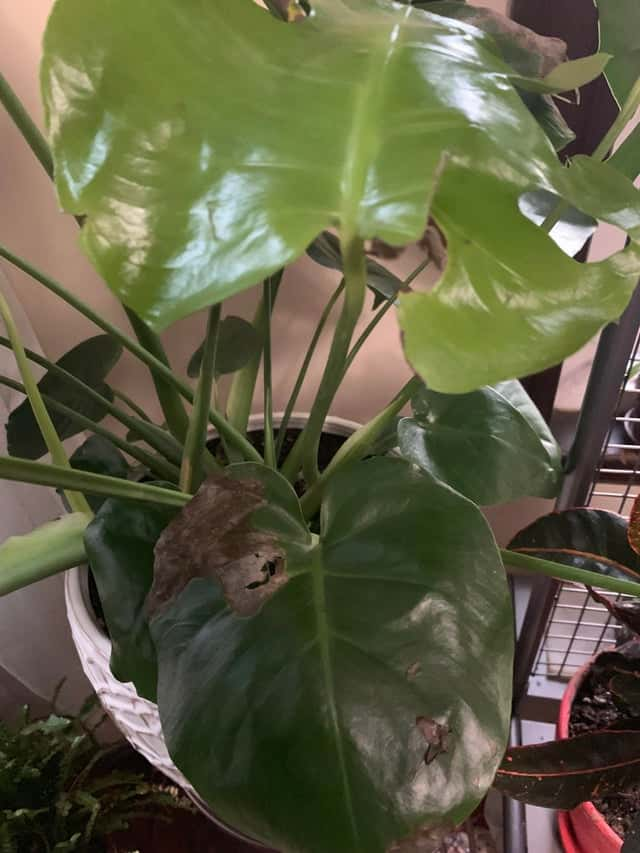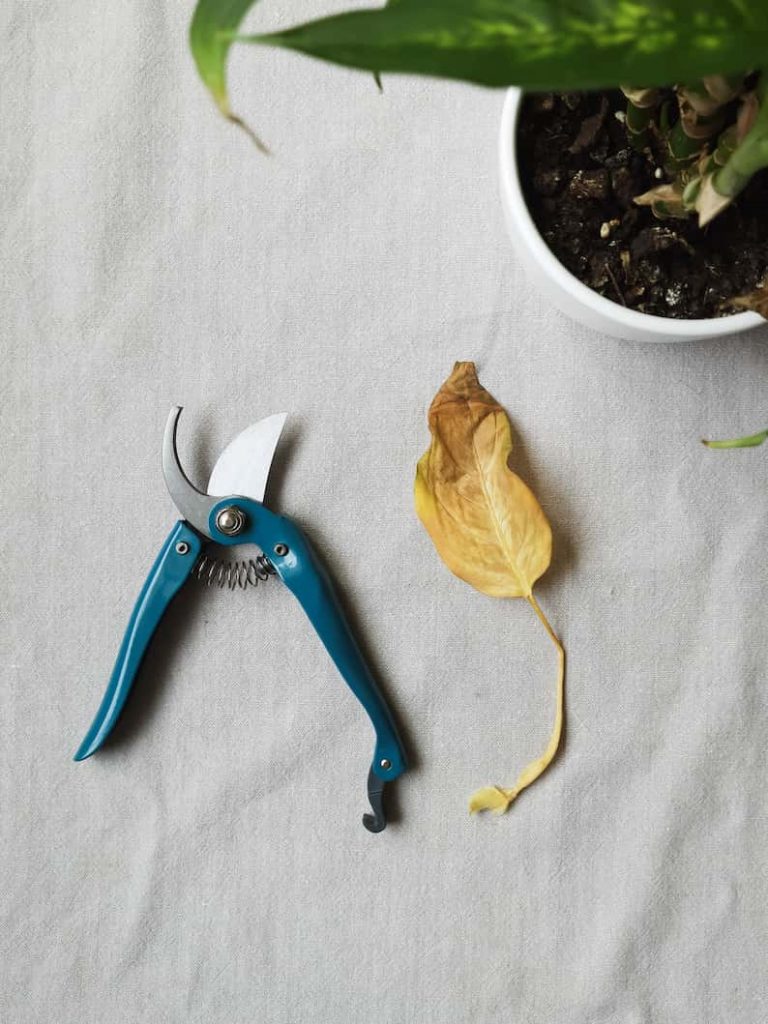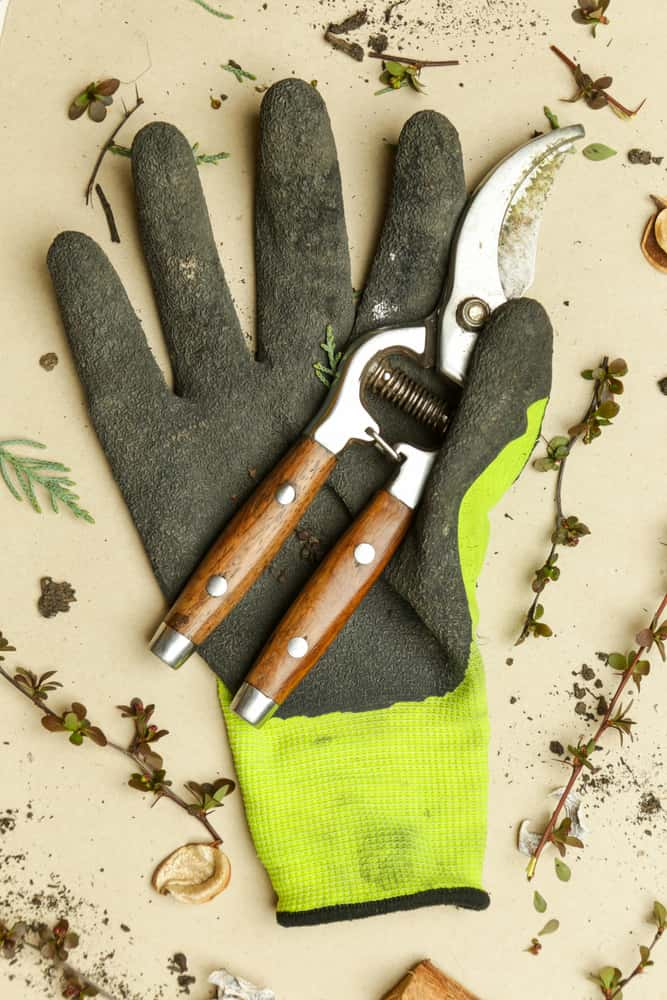Monstera plants are known for their large, showy leaves, which are bright green or variegated, which is the term for those leaves that display unique white patches. Either way, when a plant is known for its spectacular foliage like this one is, it can be disappointing when your Monstera develops brown spots on its leaves.
There are many reasons for your Monstera plants getting brown spots on the leaves. As you’ll see, the size, shape, and appearance of the spots generally offer clues to the underlying condition causing the discoloration.
Keep reading to find out the common causes of why your Swiss Cheese plant is getting brown spots to identify the problem in your specific case, as well as how to fix this.

Table of Contents
Why is my Monstera getting brown spots?
The most common reason for why your Monstera is getting brown spots is improper watering, usually due to overwatering or your plant retaining too much moisture. However, they can also develop brown spots from too much sunlight, disease, or low humidity.
Understanding why your Monstera plant is getting brown spots takes a little detective work. There are several common reasons why this can happen. Here’s a list of the most common reasons for brown spots on Monstera leaves.
1. Overwatering
Monstera plants are susceptible to root rot if the soil remains soggy or too wet for an extended period. Wet soil is often an indication of watering your plant too frequently or growing your Monstera plant in soil that does not drain well.
Having an overwatered Monstera chokes out the oxygen in the soil and causes the plant’s root to rot and turn to mush.
The first signs of root rot you are likely to observe are large, dark brown spots on the leaves of your Monstera plant. These spots may cover more than half of the leaf’s surface. You may also notice a discolored or browning stem.
Brown spots from over watering occur because the roots can no longer absorb moisture and nutrients from the soil and the foliage begins to die. In this case, you urgently need to repot your Monstera in fresh soil to save your plant (which I’ll run through how to do below).
Best soil for Monsteras
Specially designed soil for your Monstera. Light and well-draining, making it perfect for avoiding root rot, while being packed with just the right nutrients to keep your plant happy.
2. Underwatering
Underwatering your Monstera plant can also cause leaves to turn brown. However, browning leaves from under watering tend to appear along the edges of the leaves.
Brown leaves from under watering are light to medium brown and crispy. These brown spots occur because the plant isn’t receiving enough water to keep the leaves supplied with the water they need to maintain their healthy green appearance.

3. Exposure to direct sunlight
Sometimes brown spots on Monstera leaves result from damage from exposure to direct sunlight. Direct sunlight scalds the delicate leaves. They may appear white or yellow at first and gradually turn brown.
When it comes to a Monstera plant’s light needs, they thrive in bright, indirect light. However, they cannot tolerate the sun’s harsh rays. This is particularly true of the afternoon sun.
4. Fungal or bacterial disease
Fungal and bacterial diseases can cause Monstera leaves to turn brown. These brown spots typically look like small speckles and may look like tiny holes in the leaves.
In some cases, each spot typically has a yellow halo giving the leaf a buckshot appearance, but the exact color can differ depending on the specific disease. For example, if your Monstera has bacterial leaf spot, it may be a darker spot without the yellow halo – which is still a problem, unfortunately.
The fungal and bacterial disease can result from keeping your Monstera too moist, high humidity, or even from wet soil. The disease can also be spread from one plant to another during routine plant care, which is why it’s particularly important to treat brown spots on your Monstera’s leaves in this case.
Keep in mind that foliage that is misted heavily and does not dry out can also lead to issues with fungal diseases, such as rust fungus on your Monstera. As such, if you’re noting issues like this and think it could be from misting, it may be best to slow down on that for a while to see if that helps.
5. Chlorinated or treated water
Monstera plants are sensitive to the water quality they receive and prefer distilled or filtered water. Tap water that contains chlorine or other chemicals can cause the leaf tips to turn brown.
6. Low humidity
Monstera plants like humidity. They are native to tropical rainforests and prefer a humid environment with a humidity level above 60 percent. Because of this, when they are grown in less humid conditions, they may show their discontent by developing brown edges on the leaves.

7. Nutrient deficiencies
Nutrients in the soil of your Monstera plant can get depleted over time, leading to inadequate nutrients to support healthy plant growth. Failing to replace the needed nutrients by fertilizing your Monstera plants can lead to developing brown spots.
Your may notice your Monstera leaves turning yellow and then brown if your Monstera plant is not getting the nutrients it needs.
How do you fix brown spots on Monstera?
To fix brown spots on your Monstera, it’s important to identify the underlying cause of this. For example, if they are due to the most common reason, overwatering, you should adjust your watering schedule and consider repotting your Monstera to ensure its soil is draining properly.
You may also wish to prune any affected leaves.
Brown spots on your Monstera plants need attention right away. Although you can’t fix a leaf once it has turned brown, you can take steps to prevent the problem from spreading to the other leaves on your Monstera plant.
How you do this depends on the cause of the brown spots on your Monstera plant.
How to fix brown spots on Monstera from overwatering
Monstera plants suffer from wet soil and may develop root rot as a result. Monstera plants need well-drained soil that dries out slightly between waterings.
Take these steps to treat brown spots on your Monstera’s leaves caused by overwatering:
- Check the roots of your Monstera plant to determine if root rot has set in. If the roots are dark brown or black, mushy, or emit a foul odor, they likely suffer from root rot. Trim away the unhealthy roots and repot your Monstera plant in fresh soil.
- Provide your Monstera plant with well-drained soil. If the soil in your Monstera’s pot does not drain well, replace it with a quality aroid soil mix. This is my pick for the best soil for Monstera plants.
- Check that the pot has drainage holes and that the drainage holes are not clogged or blocked. Some ideas on the best pot for your Monstera may help.
- Water your Monstera plant when the soil feels dry 1 to 2 inches below the surface. And in terms of how often to water your Monstera, allow it to dry out before watering your plant again.

How do you treat root rot in Monstera?
Root rot is a group of diseases caused by several fungi that thrive in wet or soggy soil. Root rot causes the roots of your plants to rot away, explains Clemson University. Because the fungi live in the soil, treating your Monstera root rot and giving it fresh, sterile soil is essential. Here’s how:
- Remove your Monstera plant from its pot.
- Wash the existing soil free from the roots.
- Examine the roots closely.
- Trim away any brown, black, or discolored roots with a sharp, sterilized knife. Roots infected with root rot may also be mushy, depending on how far the disease has spread. Healthy roots are white or light tan and firm.
- Choose a new pot for your Monstera plant or sterilize the existing pot by scrubbing it with a solution of nine parts water to one part household bleach.
- Fill the pot with fresh, sterilized soil. See here for tips on picking the best soil for your Monstera plant.
- Position the Monstera plant in the new pot to its original growing depth and firm the soil down to secure the plant.
- Water your Monstera plant and monitor the soil moisture carefully.
- Do not water your Monstera plant again until the soil feels dry 1 to 2 inches below the surface.
How to fix brown spots on Monstera from under watering
Brown spots from under watering are easy to treat, as you’ll see by following the steps below:
- Water the plant thoroughly so water runs freely through the bottom of the pot.
- Empty the saucer or catch basin when the pot is finished draining.
- Monitor the soil moisture closely. When the soil feels dry to the touch 1 to 2 inches below the surface it is time to water your plant again.
- Do not let the soil dry out completely.
How to fix brown spots on Monstera from exposure to direct sunlight
If your plant is getting too much direct sunlight that has caused your Monstera leaves to burn and turn brown, the solution is simple. Just do the following:
- Remove the brown leaves from the plant.
- Move your Monstera plant to a location that receives bright, indirect sunlight.
- Hang a sheer curtain over the window if you must grow your Monstera plant in a location that receives direct sunlight. This will filter the light and prevent your Monstera leaves turning brown from their getting sunburned.
How to fix brown spots on Monstera from fungal or bacterial disease
When a fungal or bacterial disease strikes, removing all the infected foliage and improving air circulation around your Monstera plants is vital. You can do this by following these steps:
- Use sterilized clippers or scissors to trim the infected leaves from the plant. Put the leaves in a plastic bag and seal the bag before disposing them in the trash.
- Clean any plant debris, such as bits of fallen leaves, from around the plants.
- Check that there is adequate room for air to circulate around your plants.

How to fix brown spots on Monstera from chlorinated or treated water
Monstera plants can be sensitive to impurities in the water they receive. You can reduce these effects with a few simple steps, as follows:
- Use distilled, filtered, or rainwater to water your Monstera plants.
- Allow tap water to sit out overnight so chlorine or other chemicals can dissipate if you choose to use tap water.
- Avoid wetting the leaves when you water or mist your plants.
- Wipe spills off the foliage right away.
How to fix brown spots on Monstera from low humidity
You can treat brown spots on your Monstera’s leaves caused by low humidity levels by raising the humidity level near your Monstera plants. There are several ways to do this:
- Group your plants together. All plants, including Monstera plants, release moisture into the air in a natural process called transpiration, similar to breathing in humans. Grouping plants together takes advantage of the air’s moisture and keeps the humidity level up around the plants.
- Use pebble trays. Fill a shallow tray with pebbles and cover them with water. Place the tray under your plant pots, so the water in the pebble tray is below the bottom of the pot. As the water evaporates, it will raise the humidity level around your plants.
- Use a humidifier. Get a humidifier and install it near your Monstera plants to raise the humidity level and keep brown spots from low humidity away.
How to fix brown spots on Monstera from nutrient deficiencies
The nutrients in your Monstera’s soil can get depleted over time both because your plant is using them to grow and because they can leach through the soil with repeated waterings. Replacing the lost nutrients is essential to your Monstera plant’s health, which you can do through the following process:
- Select a balanced houseplant or Monstera fertilizer.
- Mix the solution following the application rate on the container.
- Fertilize your Monstera plant once or twice a month from spring until fall, when it is actively growing.
- Withhold fertilizer during the fall and winter when the plant rests from a long season of active growth. It is normal for growth to slow or stop altogether during this time.
- Resume fertilizing your Monstera plant in the spring when new growth appears.
Should I cut off leaves with brown spots on my Monstera?
You should cut off leaves with brown spots on your Monstera as they cannot perform photosynthesis and make energy for the plant. As they will not turn green again, even if the underlying problem is fixed, there’s no reason to keep them.
That is, the only solution for improving the health and appearance of your Monstera plant is to remove the brown leaves.
You can see our article on how to prune your Monstera for more information on this. However, in brief, use sterilized clippers or scissors, and always discard the affected leaves in the trash as you can spread diseases among your plants if you do not sterilize your cutting tools.

Will the leaves grow back when I cut them off my Monstera plant?
Leaves will grow back when you cut them off your Monstera plant, so there’s no need to worry. In fact, cutting off the affected leaves will force your Monstera plant to grow new leaves at the plant nodes along the stem. This will also improve both its health and appearance.
While it can be a bit scary to give your plant a haircut like this, especially if it starts to look much more sparse than you’re used to, don’t worry as you will soon be rewarded with new leaves on your Monstera along the stem.
Why does my Monstera have brown spots with yellow rings?
If your Monstera has brown spots with yellow rings that look like halos, these rings are typically the result of either bacterial or fungal diseases. This means that affected leaves should be removed from the plant as soon as possible to stop the disease from spreading to currently healthy leaves.
Make sure you also clean up around your plants and check the soil for any signs of mold. This may appear as fuzzy green, gray, or whitish spots on the soil. If you notice mold on your soil, replace the soil in the pot with fresh soil.
Final thoughts on your Monstera’s brown spots
It can be disheartening to discover brown spots on your Monstera plant’s leaves, but there is no reason to panic. Most brown spots on Monstera leaves are due to environmental factors you can control and correct with a little effort.
That is, by providing your Monstera plant with proper lighting, well-draining soil, adequate nutrients, and observing proper watering techniques, your Monstera’s brown spots will soon be a thing of the past.
Of course, it’s always best if you can act quickly if you notice your Monstera plants getting brown spots on the leaves. This can help to avoid the problem becoming too serious, as there’s no question that failing to treat brown spots on your Monstera’s leaves – or at least the cause of this – can have serious implications for the health of your plant.
Acting fast will also ensure that the problem doesn’t spread, including to other houseplants in your collection, which can be particularly problematic if there’s a fungal or bacterial reason behind these spots.
Ultimately, however, most reasons for these spots are fairly easy to fix once you figure out the source of the problem. And before you know it, your Monstera will be back to the showy leaves for which it’s known.

